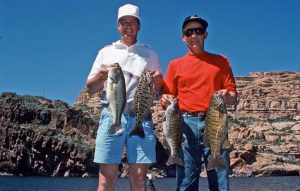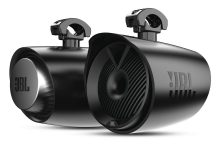AZ Lakes, AZ Pros/Lake Pleasant
Vanderkooi Has Amazing Success With Carolina Rig
I’ll never forget the year the All Star Super Team Championship at Lake Pleasant was won with a Carolina rig, and Rob VanderKooi and Lynton Leslie also took second place using the rig. Both before and since that tournament, many others have been won on Pleasant using the same technique.
Dean Farrell and Dave Deadman are two other anglers who have learned to fish this rig with incredible results. VanderKooi agreed to show us how, where, and when he uses the Carolina rig. Here’s what we learned:
The Summer/Winter Rig

Rob likes the Carolina rig in summer and winter. He looks for outside structure — good long points with a hard break- off to deep water either on one side or at the end. This kind of point will hold fish even when the water is rising or falling rapidly, VanderKooi explains, because the break makes it possible for them to move up or down to keep at a comfortable depth, while the sloping point provides an easily accessible feeding area.
During the Championship, Rob and Lynton stayed on the same spot the whole time, and weighed an incredible 36 pounds the first day. “You have to be in just the right spot,” Rob emphasizes, “If you’re even ten feet off, you’re not going to catch the fish.” Rob located this honey hole weeks before the tournament, and repeatedly checked it and kept an eye on it in the days preceding the tournament.
Another Good Point
A lot of people witnessed the impressive bag of fish that he and Lynton brought to the scales, and some people knew where the pair had been fishing, so it got pounded pretty hard; however, it didn’t take VanderKooi long to find a new honey hole. About 75 yards away was another point that looked good, this one farther out into the open water. Before he started fishing, Rob explained his rig.
“I use a flippin’ stick to fish the Carolina rig,” he began, “because it’s long enough to give me a lot of sweep-set power, and strong enough to move the line quickly to set the hook. I spool a big reel with 20-pound-test Berkley Big Game line, and I use a 15-pound-test leader.” The slightly lighter leader means that if he breaks off, he usually doesn’t lose the whole set-up, just the leader and hook.
‘That’s A Good Bait!’
Rob adds a 3/4-ounce egg sinker to the line, then threads on a glass bead before tying on the swivel with a Palomar knot. To the swivel he adds the four-foot leader of 15-pound-test Big Game line, and ties on an extra wide gap 3/0 Gamakatsu hook. The lure he likes best is a watermelon Zoom Lizard. “There’s no scent on this lure, but I think they’d digest it before they spit it out,” he declares. “You know that’s a good bait.”
Casting a Carolina rig is not easy — Rob slings it out sideways to get maximum distance, and he barely moves it once it hits bottom. “Texas rigs are for more aggressive fish, I think,” states VanderKooi. “The Carolina rig is more subtle, but if the fish start getting more active, you can always move it faster.”
During The Dog Days
During the dog days of summer, bass hold tight to the submerged trees. Rob inches the rig along, slowly easing it up and through the trees, then letting the weight fall back to the bottom. The lizard follows along behind, fluttering and waving as it gets pulled through the branches. Almost every bite occurs as the lizard falls down through the trees, so once it stops falling, VanderKooi lifts and “weighs” the line. If it feels different, he sets the hook hard and fast by sweeping the rod sideways and turning the reel hard.
“This time of year, like winter, you don’t get a lot of bites,” says Rob, “but you have a chance to get good bites by using a big bait like the lizard.” He proved his point by immediately catching a couple of five-pounders off the new spot.
“In winter, when there’s more water in the lake, I start fishing the river ends,” he continued. “There are good points like this all over this lake, and all you have to do is find them, then have the patience to fish them thoroughly.”































